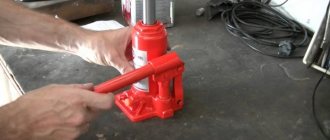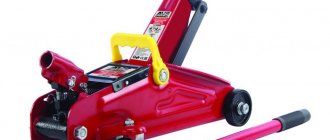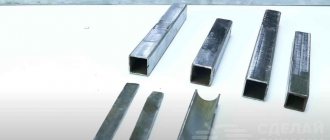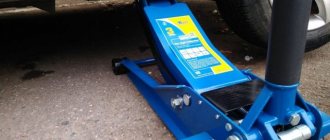The range of applications of a jack is much wider than just using it when changing tires on a car. Any experienced car owner knows when to use this device. But in addition to operating rules, it is important to know how to properly maintain and replace hydraulic material.
Unlike existing lifting mechanisms, the jack has small dimensions and weight, simple operation, convenience and a high degree of reliability. For every car owner, such a tool is a necessary and very important thing.
There are several main types of jacks:
The control can be manual or electric. Some models can handle loads of up to several hundred tons.
Hydraulic jack
A hydraulic jack is a device that allows you to lift and hold weights at a given height. Using this mechanism, you can perform the following manipulations:
- lift and hold the car body during repair work;
- raise the bridge span;
- carry out tension of high-voltage wires;
- transportation of construction materials and equipment;
- pipe laying
There are single-plunger and double-plunger models. According to the type of design, the mechanisms can be:
- bottled;
- rolling;
- hooked;
- two-level;
- diamond-shaped
Why are hydraulic models considered the best in the line of jacks? They have significant advantages:
- high efficiency (80%);
- smooth and silent;
- rigidity and strength of the structure;
- braking and stopping in a precisely specified place;
- significant carrying capacity.
But besides the advantages, it is necessary to note the disadvantages of the design:
- To avoid oil spillage, transportation must be carried out in a strictly vertical position;
- low speed;
- rise to a small height;
- inability to set the height when lowering the load.
The lifting capacity range of hydraulic models ranges from 2 to 200 tons. The most popular model is the bottle design, as it is the easiest to use.
The rolling jack can only be used on a level and hard surface. This mechanism is mounted on wheels and has a fairly large lever, which makes it difficult to reduce the impact force if necessary.
Monitoring the oil level and its cleanliness is the key to long-term, flawless operation of the mechanism.
Scope of application
A do-it-yourself manual lift greatly simplifies repair, maintenance and tuning work related to vehicles and will help in the construction and restoration of capital structures. The presence of a compact jack eliminates the need for the car owner to visit a service center or buy a factory-made device. The lifting forces of the mechanism allow the following manipulations with the load:
fix;- move;
- lift up.
Material selection
Car enthusiasts often wonder what kind of oil is needed for a jack.
Advice: choose only high quality oil and never mix it with any other fluids, including brake or other types of lubricants. Mixing will cause breakage and risk of cargo loss during the working process.
It is necessary to fill the jack with high-quality oil that meets the following indicators:
- the lubricating fluid must be well filtered;
- the level of foaming is as low as possible;
- the viscosity index and temperature maximum are selected extremely high;
- high rate of anti-corrosion protection.
To refill jacks, liquids of the I30A, I40A or I50A brands, used in the operation of industrial machines, are used. The best option is special hydraulic oil.
Oil quality
Most hydraulic fluids are measured at a typical ISO grade. However, there are some hydraulic fluids with anti-wear properties. You might come across AW 46 oil. What does this mean? AW oils will perform the same as their ISO counterparts. The main difference is that anti-wear hydraulic fluids contain different additives to reduce corrosion. Anti-wear oils ensure there is no metal-to-metal contact in the system.
Zinc is a widely used additive in anti-wear oils because it extends equipment life. Another reason to use zinc supplements is that they have both anti-wear and antioxidant properties. Anti-wear hydraulic oils are recommended for use in harsh conditions.
If you use fluid that is too thick, the machine may not be able to pump the oil out of the reservoir effectively. This may lead to cavitation. On the other hand, using thinner oil may cause internal slipping inside the jack, reducing its effectiveness.
A hydraulic jack operating in a cold zone will perform best with a low hydraulic jack oil level of 32. If the hydraulic system manufacturer has specified the grade of oil to be used, it is advisable to use that grade. The manufacturer tested the system to determine which grade was best for the jack.
In addition to reliable control of all types of contaminants, the behavior of hydraulic fluids in flow plays a decisive role in operation and especially at extreme temperatures. These properties are described by the viscosity index (VI) and affect the reliable lubrication of all components. VI is calculated from kinematic viscosity at 40 and 100 degrees. A low VI value means poor lubrication in the cold and a sharp drop in viscosity in the heat.
If the fluidity of the lubricant used is insufficient, that is, too viscous, fatigue reactions and wear occur. The result is slow response times and increased power consumption. A stable lubricant should perform well even at high temperatures. If the hydraulic oil becomes too thin, there is a risk of wear and cavitation. High quality base oils used with naturally high VI and additives ensure the best response and maximum performance at all temperatures.
Refueling mechanisms
Next, we’ll look at how to properly fill the recommended oil into a jack. Sometimes, if transported incorrectly, hydraulic fluid can spill out and the voids can be filled with air. This will cause the jack to fail. In this case, an oil change is necessary.
The rack and pinion mechanism is quite large; it is used not only for lifting the body, but also for repairing old buildings. Before changing the lubricant, the mechanism must be completely lowered. To verify this, you can relieve residual stress by turning the exhaust valve counterclockwise.
The neck into which the filling is made is usually located on the tank body, usually in the lower part of the cylinder. It is necessary to free the neck from the bolt or plug that reliably protects the oil in the container. Then you will need an oil can, the nozzle of which must be inserted into the neck and filled.
Changing the oil in the jack
One of the reasons for slow operation or complete stop of the jack may be oil leakage during transportation or improper storage. Air takes the place of the working fluid, which has a bad effect on functionality.
Before adding new oil, it is advisable to disassemble the jack and thoroughly clean the piston from dirt and rust. You can change the gaskets, the damage of which is not always noticeable. But with prolonged use, they gradually wear out and under pressure do not provide sufficient density.
To change the oil, there is a special hole with a plug on the thread. The device must first be thoroughly pumped to remove all excess air. The old oil is drained and replaced with new oil.
When draining the oil, you may lose the metal ball from the valve. This is an important part, without which the device will not work. Therefore, draining is done carefully.
No special tools are needed for this. Which oil is suitable for a jack, and which should never be used? Oil may differ in density and content of mineral additives. It matters what kind of oil is used. This must be a technical oil suitable for industrial equipment: brands ISOA, I40A, I30A or I50A. It is best to fill with hydraulic oil.
You need to fill the oil up to the special mark marked on the body. The oil should completely fill the housing, without air bubbles or voids. After refueling, the jack must be closed and pumped again, raising the piston all the way. Open the plug, add oil and repeat until oil starts flowing out instead of air. This means everything was done correctly. It is advisable to find an assistant: one holds the device in the desired position and presses, the second pumps.
Video instructions for repairing and refilling oil:
Main causes of breakdowns
A rolling jack, which can be repaired at home, can have several causes of breakdowns. The most common of them are: complete or partial failure of the device to lift heavy loads, as well as oil leakage. Each of these problems requires immediate repair.
The rolling jack (repair, oil change, characteristics are described in detail in this article) very often fails as a result of oil leakage. In this case, you will have to completely disassemble the device. Be sure to remove the pistons and check for corrosion. Thoroughly clean all structural elements and remove all kinds of dirt. Now check the stem. If you find that it is warped and damaged, you may not even try to repair it yourself. In this case, you will most likely have to purchase a new jack.
Another common reason for device failure is clogging or breakdown of special valves, which, in fact, are responsible for lowering and raising the mechanism.
Rolling jack: valve repair
When starting to repair the oil valve, unscrew it and check for accumulated dirt. Also, do not forget to pay attention to the presence of various types of deformations. If you notice even the slightest change in the appearance of the valve, replace it with a new one immediately.
If you find a large accumulation of contaminants, then, without cleaning the valve, you will begin to notice how oil flows out. This is due to the fact that the ball does not fit very tightly into the socket.
Valves flushing
Repair of rolling hydraulic jacks should begin with thorough washing of the valves. This is done in order to thoroughly clean the device of all accumulated contaminants. Before carrying out this procedure, prepare in advance a special container into which you will pour the old liquid. While the fluid is draining, be sure to bleed the system. This must be done using the operating lever by lowering and raising.
After this procedure, which in no case should be ignored, the valves are washed, which cleans the device of the remains of old working fluid and accumulated contaminants. Repairing a rolling car jack on your own involves the mandatory replacement of all cuffs and sealing gaskets. If contaminants get directly into the work surface, clean it by unscrewing the housing head.
Now fill the tank with a special flushing liquid or kerosene and pump it. Once you have done this, fill the reservoir with clean working fluid.
Malfunction caused by air bubbles
Very often, the jack may begin to malfunction due to reasons such as the accumulation of air bubbles in the working area. Most often, this phenomenon occurs with a very small amount of oil.
Repairing rolling hydraulic jacks with this problem can be done at home. First, you will have to remove the plug in the oil reservoir, opening the bypass valve. After this procedure, you should quickly bleed the pump of your jack. By the way, this needs to be done at a very fast pace. With this procedure you will be able to transfer the bubbles into the oil container.
Selecting and purchasing a quality jack
If you want to buy a 3t rolling jack, then, no matter how expensive your tool is, it will still break down periodically. Therefore, you just need to familiarize yourself with the basic rules of its operation, as well as the basics of repairs at home. In order to do the repair work yourself, do not forget to buy a special set of wrenches, as well as a special flushing fluid and oil.
When choosing a hydraulic rolling jack, you need to consider several parameters. If you want to use it at home, then you can buy a unit that will be ideally suited to the weight of your car. Most often this is a 3t rolling jack. If you want to buy a device for working in a workshop, then you will need a device with a large load capacity and high lifting speed. When buying a jack, it is better not to save money, as a high-quality product will break less often and will last you much longer.
Methods for pumping other types
Bleed a bottle-type hydraulic jack with your own hands. Jacks of this type have a very simple structure and operating principle. Installed in freight vehicles intended for transporting heavy loads. The minimum lifting capacity of a bottle jack is 3 tons, and the maximum is up to 200 tons.
There are 2 types of vertical hydraulic jack: single-rod and double-rod. The first has a simple design and is very easy to use; it is mainly used for installation work in construction, car repair and for other purposes. The operating principle of the second is based on the installation of two rods, due to which a high load capacity is achieved.
As for pumping technology, a bottle jack is no different from a rolling jack. To bleed a hydraulic bottle jack, it is also necessary to clean the mechanism from working fluid and oil. To clean, you need to unscrew the valve and drain the used fluid, and then the oil by bleeding the pump.
If the equipment, even after replacing the fluid and oil, continues to not work correctly, then you need to once again check the working area for the presence of air accumulated during operation. To remove it, open the bypass valve and the plug from the oil container and pump the pump until air bubbles are completely removed from the working cylinders. And then close the bypass valve and the lid of the oil container.
It may also be necessary to bleed a 5 ton hydraulic jack in case of contamination and air ingress. A jack with a lifting capacity of 5 tons is usually used in car repair shops. Therefore, a car jack needs bleeding more than others due to heavy load. To bleed a 5 ton jack, you need to carry out the same steps as those discussed above. The main purpose of pumping is to remove accumulated air, and it is important to repeat pumping until it is completely removed from the working mechanism, otherwise the jack will not be able to lift even the lightest load.
>
Rules of care
If a 2-ton rolling jack does not lift, repairs can be carried out at home. But to prevent this from happening, timely prevention must be carried out. Of course, no one says that the device will last indefinitely, but you can extend its service life several times.
Provide good storage conditions for the jack. Monitor the quantity and quality of the working fluid. Clean the device from dirt in a timely manner. Do not forget that it is not recommended to overload the device.
Recommendations
Those companies that produce motor lubricants sometimes additionally produce hydraulic fluids for cars and trucks. These fluids can be used to fill not only the jack, but also the brake systems. In addition to the usual special oil, industrial types of oils are sometimes used (such as I-12A, I-30A, I-50A) . However, here you need to be careful and have a good understanding of cars, or carefully study this topic: some oils are extremely viscous and are not suitable for every device. They can also damage the jack by causing corrosion.
There are some liquids that it is better not to pour into the jack at all to avoid negative consequences.
In general, the device can work even if you just pour water into it, but the surface will quickly become covered with rust and it will most likely be impossible to return to its previous operation. Those who like to pour regular machine oil into jacks will encounter the same problem, just later: regular machine oils also cause water to accumulate in the device. Over time, it will also fail.
In order for the forklift to work properly, the hydraulic solution must be changed regularly. It is inconvenient to work alone - here it is better to take someone as an assistant. Before you start pouring liquid, it is important to first carefully study the instructions for using the device and do everything as indicated in it, since depending on the type of device, changing the liquid may take place differently. Unless absolutely necessary, it is better not to completely disassemble the device again, as there is a risk of losing the ball or damaging the valves.
It is strongly recommended not to fill the jack with liquid that contains alcohol. The use of alcohol-containing liquids will also lead to corrosion and further inoperability of the device. In addition, no valves other than the outlet valve should be opened. By opening the check valve or overload valve, you can harm the bearing or spring, so even in such a simple operation as changing the oil in the device, you should be extremely careful and careful.
It is recommended not to spare money on filling. It’s better to take a more expensive one, but with positive characteristics (viscosity, composition), then it will need to be changed less often, and the lift will last longer, since it will not rust or deteriorate in a short time . Experts do not recommend mixing expensive and cheap liquids, as this will only worsen the effect.
Once there is less oil than the unit requires, you will immediately notice how much more difficult it will be to lift heavier objects. This is the first signal that you need to top up or change the special solution. Once the primary signs of a malfunction have been detected, it is advisable to eliminate it as quickly as possible, then the device will always be in optimal operating condition, and the car owner will be able to avoid accidents that may occur due to a malfunction of the device.
For information on how to bleed a hydraulic jack, see below.
Helpful operating tips
Immediately before the oil filling process, carefully read the operating instructions for your particular model of hydraulic jack. After all, sometimes there are cases when the oil filling process is slightly different from that described above.
Before starting use, it is recommended to get rid of excess accumulated air in the device. Raise the device and lower it to the minimum. This will remove all unnecessary air.
Use only time-tested liquids. Do not use liquids containing alcohol.
How to do something yourself, with your own hands - home craftsman website
AN EXCELLENT TOOL FOR CRAFTERS AND HANDCRAFTS AND EVERYTHING FOR THE GARDEN, HOME AND Cottage LITERALLY FOR FREE - SEE FOR YOURSELF. THERE ARE REVIEWS.
All these years I worked as a mechanical jack, the advantages of which, other than accessibility and compactness, in general, there is nothing to attribute.
The extremely small support area, together with the constant need to place various types of bars, significantly slowed down and complicated the work. Another type of jack, which I became acquainted with later, is pneumatic, powered by compressed air (compressor).
The support area of such jacks is much larger, and the load they can withstand allows them to work with serious cargo transport or a log house.
We will pay attention to a more affordable price, but whose performance is many times higher than that of a mechanical-hydraulic jack. Hydraulic jacks are ideal not only for car repairs, but also for construction work!
TOOLS FOR HOME AND GARDEN, HANDCRAFTS, ETC. PRICES VERY LOW
A hydraulic jack is a simple tool in its design and principle of operation, which requires more control than painstaking repairs. If you follow the simple list of recommendations indicated above, then you will be able to postpone the maintenance of the jack for several years, thereby saving part of your budget.











